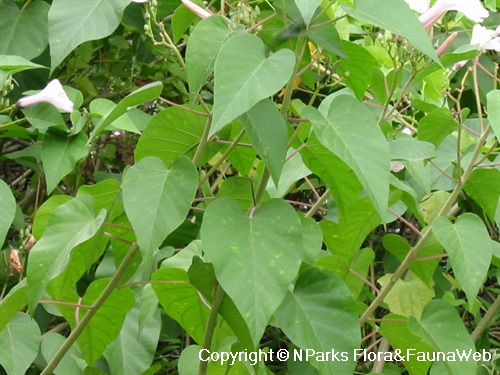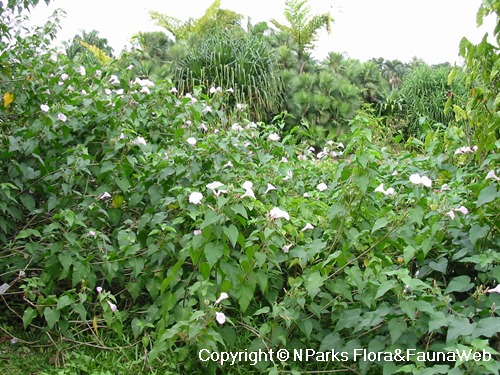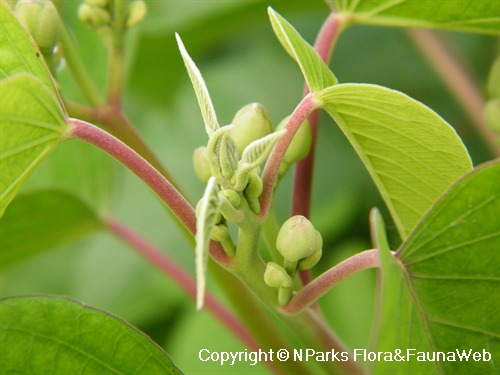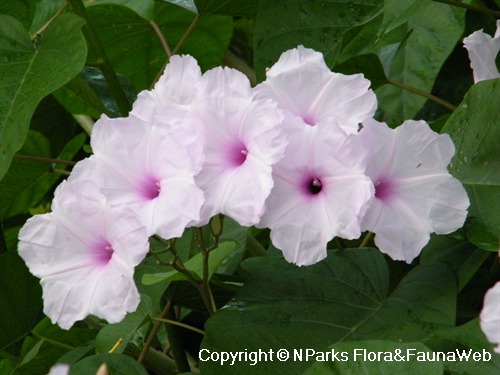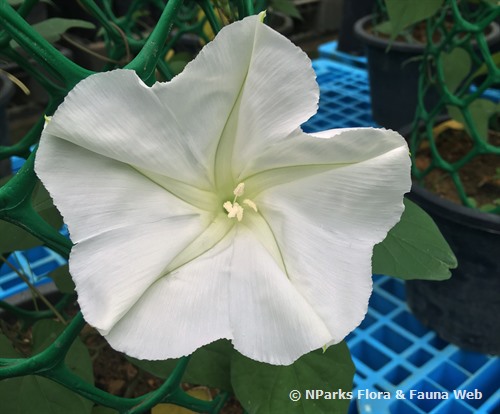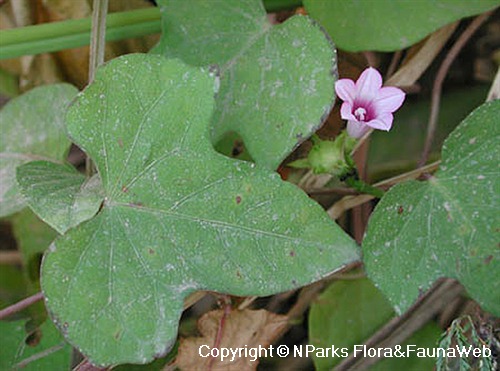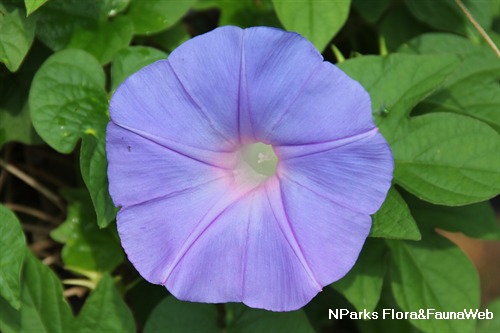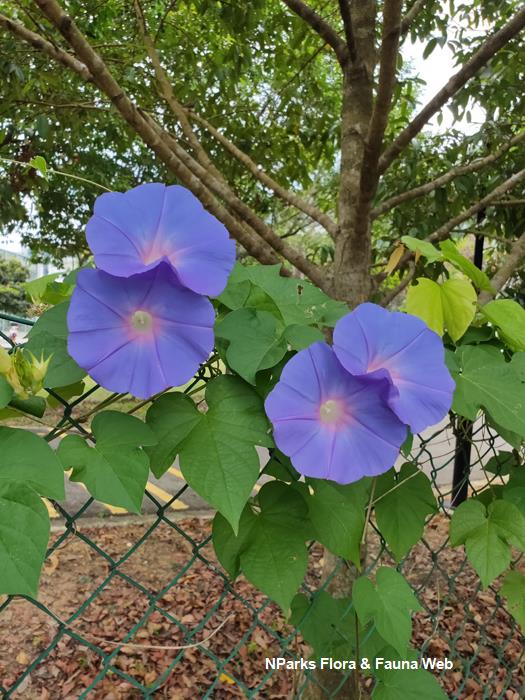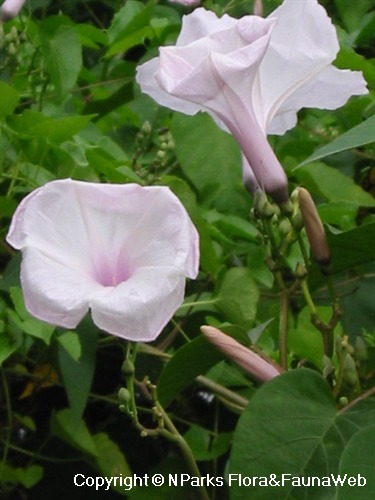
Back
Ipomoea carnea subsp. fistulosa
| Family Name: | Convolvulaceae |
| Synonyms: | Ipomoea gossypioides, Ipomoea fistulosa, Ipomoea fistulosa var. nicaraguensis, Ipomoea batatilla, Convolvulus batatilla, Batatas crassicaulis, Ipomoea fruticosa, Ipomoea texana, Ipomoea nicaraguensis |
| Common Name: | Bush Morning Glory, Pink Morning Glory, Besharam, Badoh Negro, Borrachero, Matacabra, 树千牛 |
Name
Classifications and Characteristics
| Plant Division | Angiosperms (Flowering Seed Plants) (Dicotyledon) |
|---|---|
| Plant Growth Form | Climber, Shrub |
| Lifespan (in Singapore) | Perennial |
| Mode of Nutrition | Autotrophic |
| Maximum Height | 5 m |
Biogeography
| Native Distribution | Tropical America |
|---|---|
| Native Habitat | Terrestrial |
| Preferred Climate Zone | Tropical |
| Local Conservation Status | Non-native (Spontaneous (Casual)) |
Description and Ethnobotany
| Growth Form | A robust, fast-growing, erect shrub or climber that constantly produces eye-catching pink trumpet-like flowers pleasantly accompanied by light green heart-shaped leaves. |
|---|---|
| Foliage | Leaves simple, ovate-lanceolate (oval to lance-shaped; narrow and tapering to a pointed apex), alternate, light green, 10 to 25 cm long, pubescent (covered with soft, short hair) especially beneath; petioles 4.2 to 6.2 cm long. |
| Stems | Stem woody, light brown to beige, hollow, slender, glabrous (smooth; not rough or hairy). |
| Flowers | Flowers in cymes, trumpet-shaped, a smooth blend of white with pale pink to purple, with a darker purplish corolla throat, 5 to 9 cm long, up to 11 cm in diameter, clustering at end of branches; pedicel 0.5 to 1.5 cm long, perianth 2, whorled; calyx 5 to 6 mm long, corolla 4 to 8 cm long; sepals 5, all of which free; petals 5, all joined in a funnel shape; stamens 5, |
| Fruit | Fruits ovoid (oval), glabrous, capsule-like, non-fleshy, dehiscent, up to 2 cm long and 1.5 cm wide, pale brown brown when ripe; seeds black, about 1 cm long, covered with long, woolly, brown trichomes (hair-like outgrowth). |
| Cultivation | Being a robust perennial and able to adapt to a wide range of soil types, it is grown best in well-draining, fertile soils. It prefers full sun to partial-shade, but requires a structure like a trellis, fence or wall for support should it be grown as a tall, erect shrub. Alternatively, allow branches to arch downwards for a more natural look. Drought tolerant once established. Propagate by seeds and (soft wood) stem cuttings. Caution: Seeds are toxic to livestock and should be monitored with the presence of pets. Plant is also known to be allelopathic (having the ability to release chemical substances that inhibits the growth of other species of plant(s) around it. Note: Plant is easily differentiated from other morning glory species by its distinctive shrubby, not vine-like habit. |
| Etymology | The genus epithet 'Ipomoea' derives from the Greek 'ips', 'a worm', and 'homoios', 'like or same', in reference to the trailing or creeping habit of the plants in this genus. The species epithet 'carnea' means 'flesh-coloured' in Latin, which refers to the pale, flesh pink flowers of the plant. Its subspecies epithet 'fistulosa' means 'hollow like a pipe but closed at both ends', an allusion to its hollow stems. |
| Ethnobotanical Uses | Medicinal: Roots have laxative effects and are boiled and used to provoke menstruation, and are traditionally a treatment for skin diseases. Milky sap of plant has been traditionally used to treat Leucoderma and other related skin diseases (only external applications have been recommended due to the plant's poisonous nature). Plant has depressant effect on central nervous system and also shows muscle relaxant properties. Others: Its stems can be used for making paper. |
Landscaping Features
| Desirable Plant Features | Ornamental Flowers, Ornamental Foliage |
|---|
Plant Care and Propagation
| Light Preference | Full Sun |
|---|---|
| Water Preference | Moderate Water, Lots of Water |
| Plant Growth Rate | Fast |
Foliar
| Foliage Retention | Evergreen |
|---|---|
| Mature Foliage Colour(s) | Green, Green - Light Green |
| Mature Foliage Texture(s) | Velvety / Furry / Tomentose |
| Prominent Young Flush Colour(s) | Green, Green - Light Green |
| Young Flush Texture(s) | Velvety / Furry / Tomentose |
| Foliar Type | Simple / Unifoliate |
| Foliar Arrangement Along Stem | Alternate |
| Foliar Attachment to Stem | Petiolate |
| Foliar Shape(s) | Non-Palm Foliage (Ovate, Lanceolate, Cordate) |
| Foliar Venation | Pinnate / Net |
| Foliar Margin | Entire - Wavy / Undulate |
| Foliar Apex - Tip | Acuminate |
| Foliar Base | Cordate |
Non - Foliar and Storage
| Stem Type & Modification | Woody |
|---|
Floral (Angiosperm)
| Flower & Plant Sexuality | Bisexual Flowers |
| Flower Colour(s) | Pink, Purple, White |
|---|---|
| Flower Texture(s) | Smooth |
| Flower Grouping | Cluster / Inflorescence |
| Flower Location | Terminal |
| Individual Flower Shape | Trumpet-shaped |
| Inflorescence Type | Cyme |
| Flowering Period | Free-Flowering |
Fruit, Seed and Spore
| Mature Fruit Colour(s) | Brown |
|---|---|
| Fruit Classification | Simple Fruit |
| Fruit Type | Dehiscent Dry Fruit |
| Mature Seed Colour(s) | Black |
| Mature Seed Texture(s) | Hairy / Hirsute |
Image Repository
Others
| Master ID | 133 |
|---|---|
| Species ID | 1429 |
| Flora Disclaimer | The information in this website has been compiled from reliable sources, such as reference works on medicinal plants. It is not a substitute for medical advice or treatment and NParks does not purport to provide any medical advice. Readers should always consult his/her physician before using or consuming a plant for medicinal purposes. |

